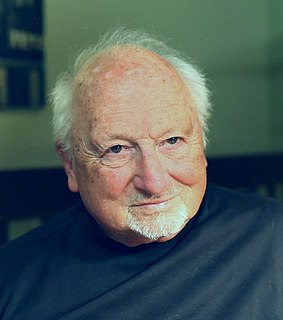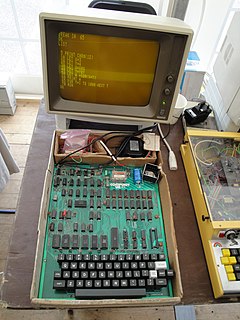
A microprocessor is a computer processor where the data processing logic and control is included on a single integrated circuit, or a small number of integrated circuits. The microprocessor contains the arithmetic, logic, and control circuitry required to perform the functions of a computer's central processing unit. The integrated circuit is capable of interpreting and executing program instructions and performing arithmetic operations. The microprocessor is a multipurpose, clock-driven, register-based, digital integrated circuit that accepts binary data as input, processes it according to instructions stored in its memory, and provides results as output. Microprocessors contain both combinational logic and sequential digital logic, and operate on numbers and symbols represented in the binary number system.
In processor design, microcode is a technique that interposes a layer of computer organization between the CPU hardware and the programmer-visible instruction set architecture of the computer. Microcode is a layer of hardware-level instructions that implement higher-level machine code instructions or internal state machine sequencing in many digital processing elements. Microcode is used in general-purpose central processing units, although in current desktop CPUs, it is only a fallback path for cases that the faster hardwired control unit cannot handle.

The MOS Technology 6502 is an 8-bit microprocessor that was designed by a small team led by Chuck Peddle for MOS Technology. The design team had formerly worked at Motorola on the Motorola 6800 project; the 6502 is essentially a simplified, less expensive and faster version of that design.

The 6800 is an 8-bit microprocessor designed and first manufactured by Motorola in 1974. The MC6800 microprocessor was part of the M6800 Microcomputer System that also included serial and parallel interface ICs, RAM, ROM and other support chips. A significant design feature was that the M6800 family of ICs required only a single five-volt power supply at a time when most other microprocessors required three voltages. The M6800 Microcomputer System was announced in March 1974 and was in full production by the end of that year.

The Motorola 6809 ("sixty-eight-oh-nine") is an 8-bit microprocessor CPU with some 16-bit features. It was designed by Motorola's Terry Ritter and Joel Boney and introduced in 1978. Although source compatible with the earlier Motorola 6800, the 6809 offered significant improvements over it and 8-bit contemporaries like the MOS Technology 6502, including a hardware multiplication instruction, 16-bit arithmetic, system and user stack registers allowing re-entrant code, improved interrupts, position-independent code and an orthogonal instruction set architecture with a comprehensive set of addressing modes.

MOS Technology, Inc., later known as CSG , was a semiconductor design and fabrication company based in Audubon, Pennsylvania, in the United States. It is most famous for its 6502 microprocessor and various designs for Commodore International's range of home computers.
In computer architecture, 8-bit integers or other data units are those that are 8 bits wide. Also, 8-bit CPU and ALU architectures are those that are based on registers or data buses of that size. Memory addresses for 8-bit CPUs are generally larger than 8-bit, usually 16-bit, while they could in theory be 8-bit, and in some situations 8-bit addresses are also used with 16-bit addresses mainly used. '8-bit' is also a generation of microcomputers in which 8-bit microprocessors were the norm.

Charles Ingerham Peddle was an American electrical engineer best known as the main designer of the MOS Technology 6502 microprocessor, the KIM-1 single-board computer, and its successor, the Commodore PET personal computer, both based on the 6502.

William (Bill) David Mensch, Jr., is an American electrical engineer born in Quakertown, Pennsylvania. He was a major contributor to the design of the Motorola 6800 8-bit microprocessor, was part of the small team led by Chuck Peddle that created the MOS Technology 6502, and he designed the 16-bit successor to the 6502, the 65816.

Bank switching is a technique used in computer design to increase the amount of usable memory beyond the amount directly addressable by the processor instructions. It can be used to configure a system differently at different times; for example, a ROM required to start a system from diskette could be switched out when no longer needed. In video game systems, bank switching allowed larger games to be developed for play on existing consoles.

The Western Design Center (WDC), located in Mesa, Arizona, United States, is a company which develops intellectual property for, and licenses manufacture of, MOS Technology 65xx based microprocessors, microcontrollers (µCs), and related support devices. WDC was founded in 1978 by a former MOS Technology employee and coholder of the MOS Technology 6502 patent, Bill Mensch.

The Compukit UK101 microcomputer (1979) is a kit clone of the Ohio Scientific Superboard II single-board computer, with a few enhancements for the UK market - notably replacing the 24×24 screen display with a more useful 48×16 layout working at UK video frequencies. The video output is black and white with 256 characters generated by a two kilobyte ROM. It has no bit-mapped graphics capability. The video is output through a UHF modulator, designed to connect to a TV set.

The Western Design Center (WDC) 65C02 microprocessor is an enhanced CMOS version of the popular nMOS-based 8-bit MOS Technology 6502. The 65C02 fixed several problems in the original 6502 and added some new instructions, but its main feature was greatly lowered power usage, on the order of 10 to 20 times less than the original 6502 running at the same speed. The reduced power consumption made the 65C02 useful in portable computer roles and microcontroller systems in industrial settings. It has been used in some home computers, as well as in embedded applications, including medical-grade implanted devices.
The Ricoh 5A22 is an 8/16-bit microprocessor produced by Ricoh for the Super Nintendo Entertainment System (SNES) video game console. It is based on the 8/16-bit WDC 65C816, which was developed between 1982 and 1984 for the Apple IIGS personal computer. It has 92 instructions, an 8-bit data bus, a 16-bit accumulator, and a 24-bit address bus. The CPU runs between 1.79 MHz and 3.58 MHz, and uses an extended MOS Technology 6502 instruction set.
The CSG 65CE02 is an 8/16-bit microprocessor developed by Commodore Semiconductor Group in 1988. It is a member of the MOS Technology 6502 family, developed from the CMOS WDC 65C02 released by the Western Design Center in 1983.
The 65xx family of microprocessors, consisting of the MOS Technology 6502 and its derivatives, the WDC 65C02, WDC 65C802 and WDC 65C816, and CSG 65CE02, all handle interrupts in a similar fashion. There are three hardware interrupt signals common to all 65xx processors and one software interrupt, the BRK instruction. The WDC 65C816 adds a fourth hardware interrupt—ABORT, useful for implementing virtual memory architectures—and the COP software interrupt instruction, intended for use in a system with a coprocessor of some type.
The Mitsubishi 740, also known as MELPS 740, is a series of 8-bit CMOS microcontrollers and microprocessors with an enhanced MOS Technology 6502 compatible core based on the expanded WDC 65C02. The ICs were manufactured by Mitsubishi Electric during the 1980s and 1990s.
In computer architecture, 16-bit integers, memory addresses, or other data units are those that are 16 bits wide. Also, 16-bit CPU and ALU architectures are those that are based on registers, address buses, or data buses of that size. 16-bit microcomputers are computers in which 16-bit microprocessors were the norm.

The W65C816S is an 8/16-bit microprocessor (MPU) developed and sold by the Western Design Center (WDC). Introduced in 1983, the W65C816S is an enhanced version of the WDC 65C02 8-bit MPU, itself a CMOS enhancement of the venerable MOS Technology 6502 NMOS MPU. The 65C816 was the CPU for the Apple IIGS and, in modified form, the Super Nintendo Entertainment System.

The Gigatron TTL is a retro-style 8-bit microcomputer, where the CPU is implemented by a set of TTL chips instead of a single microprocessor, imitating the hardware present in early arcades. Its target is the computing enthusiasts, for studying or hobby purposes.












